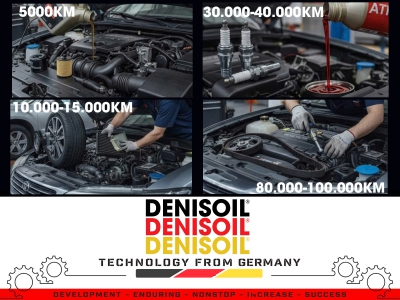GUIDE TO CHOOSING SCOOTER OIL: WHAT DO EXPERTS RECOMMEND?
Scooters can be worth tens or even hundreds of millions of VND. However, while owners often focus on appearance, maintenance and oil selection – factors that directly affect engine lifespan – are often overlooked. Here are important tips to help owners choose the correct oil and protect the “heart” of their scooter.
1. Maintenance and Proper Oil Selection – Key Factors for Vehicle Longevity
The true value of a scooter lies not only in its design but also in its durability and long-term cost efficiency. Two key factors to achieve this are:
- Timely maintenance
- Using the correct oil type for the engine
Owners should pay attention to unusual signs such as:
- Engine overheating
- Sluggish acceleration
- Noisy or hard-to-start engine
- Higher-than-normal fuel consumption
If these symptoms appear, check and service the scooter immediately to avoid serious damage.
2. How Often Should You Change Oil and Service a Scooter?
2.1 For New Scooters (Break-in Period)
- First oil change: After 300–500 km or about 1 month (whichever comes first) to remove metal shavings and contaminants from initial part friction.
- Second oil change: After 1,000–1,500 km or about 2 months.
- From the third change onward: Maintain every 1,500–2,000 km or every 2–3 months, depending on operating conditions.
TABLE – OIL CHANGE INTERVALS FOR 4-STROKE SCOOTERS
|
Vehicle Type & Usage
|
Oil Type
|
Change Interval (km)
|
Change Interval (Time)
|
Technical Notes
|
|
New scooters – break-in (0–1,500 km)
|
Any type (semi- or fully synthetic recommended)
|
1st: 300–500 km
2nd: 1,000–1,500 km
|
1st: ~1 month
2nd: ~2 months
|
Remove metal shavings & impurities from initial wear.
|
|
Post break-in / Good condition
|
Mineral / Semi-Synthetic / Fully Synthetic
|
Mineral: 1,000–1,500 km
Semi: 1,500–2,000 km
Fully: 2,000–2,500 km
|
Mineral: 1.5–2 months
Semi: 2–2.5 months
Fully: 2.5–3 months
|
Mineral oil degrades faster; fully synthetic offers better thermal & oxidation stability.
|
|
Older scooters (healthy engine)
|
Semi / Fully Synthetic
|
Semi: 1,500–2,000 km
Fully: 2,000 km
|
Semi: 2 months
Fully: 2.5 months
|
Check oil consumption; shorten interval if oil loss is high.
|
|
Older scooters (worn engine, high oil consumption)
|
High-quality mineral / Semi-Synthetic
|
Mineral: 800–1,000 km
Semi: 1,000–1,500 km
|
Mineral: ~1 month
Semi: 1.5 months
|
Use higher viscosity (10W-40, 15W-40) to compensate for part clearance, reduce oil leakage.
|
|
Harsh conditions (heavy loads, steep slopes, traffic jams, high temps)
|
Semi / Fully Synthetic
|
Semi: 1,000–1,500 km
Fully: 1,500–2,000 km
|
Semi: 1.5–2 months
Fully: 2–2.5 months
|
Heat & dust degrade oil faster, requiring earlier changes.
|
|
Infrequent use (long idle periods, low mileage)
|
Any type
|
—
|
Mineral: 3 months
Semi: 4 months
Fully: 5–6 months
|
Oil oxidizes and absorbs moisture over time; change even if km not reached.
|
Standard Oil Capacity:
- Common scooters: 0.8–1.0 liters
- Premium/large displacement scooters (SH, Vespa, ADV…): 1.0–1.2 liters
Follow manufacturer recommendations—avoid underfilling or overfilling to maintain lubrication efficiency.
2.2 For Older Scooters
- Healthy engine with quality synthetic oil: every 1,500–2,000 km.
- Harsh operation or weak engine: every 1,000–1,500 km.
- Worn engines: choose higher viscosity oil (10W-40 or 15W-40) for better protection.
Technical Tips:
- Do not delay oil changes—degraded oil loses lubrication, increases engine heat, fuel use, and wear.
- During servicing, also check the air filter and spark plug to maintain performance.
3. Why Scooters Need Special Oil
Unlike manual motorcycles, scooters use a CVT (belt drive, dry clutch, high RPM) → oil must:
- Resist high temperatures without degrading
- Have strong oxidation stability to prevent deposits and discoloration
- Maintain viscosity stability throughout use
- Provide optimal lubrication at high speeds
Using manual bike oil or low-quality oil in scooters can cause overheating, lower efficiency, and engine damage.
4. How to Read and Choose Oil Specifications
4.1 Oil Types
- Mineral Oil:
- Derived from crude oil, few additives, low cost.
- Pros: suitable for old/simple engines, affordable.
- Cons: degrades quickly, poor high-temp resistance → short change intervals.
- Semi-Synthetic:
- Blend of mineral & synthetic oils.
- Pros: balance between performance & cost, better heat resistance than mineral, good for common scooters.
- Cons: average lifespan, must follow change schedule.
- Fully Synthetic:
- Man-made, rich in anti-wear & anti-oxidation additives.
- Pros: superior heat stability, reduces friction, best engine protection, ideal for premium scooters.
- Cons: higher price, but longer change intervals.
4.2 JASO Standards
- JASO MB: Low friction, fuel-efficient → standard for 4-stroke scooters.
- JASO MA/MA2: For manual/clutch bikes → unsuitable for scooters.
4.3 API Standards
- From low to high: SF → SJ → SL → SM → SN
- API SN: Latest, best protection, anti-deposit, fuel-saving.
4.4 SAE Viscosity
Example: 10W-40, 5W-40, 10W-50
- Number before W: cold viscosity, lower = easier cold start & fuel saving.
- Number after W: hot viscosity, higher = better high-temp protection.
Technical Recommendations:
- New/premium scooters (large engines, high RPM, tight tolerances): SAE 5W-30 or 10W-30, 5W-40, 10W-40 (prefer 5W-30/5W-40 for easy start & fuel economy). Use fully or semi-synthetic API SN/SP, JASO MB.
- Older scooters (looser tolerances, reduced power, heat or oil consumption): SAE 10W-40 or 15W-40, semi or fully synthetic, or mineral API SM/SL/SN, JASO MB.
TABLE – OIL VISCOSITY GUIDE FOR SCOOTERS
|
Condition
|
SAE Viscosity
|
API
|
JASO
|
Oil Type
|
Technical Notes
|
|
New premium (SH, Vespa, PCX, ADV, Forza… <3 years)
|
5W-30, 5W-40 (preferred) or 10W-40
|
API SN, SP
|
JASO MB
|
100% Synthetic
|
Thin cold viscosity → easy start, fuel saving; high-temp stable, optimal high-RPM lubrication.
|
|
New common (Vision, Lead, Air Blade, Grande…)
|
5W-40 or 10W-40
|
API SM or SN
|
JASO MB
|
Semi or Fully Synthetic
|
Balanced performance & cost; suitable for city use.
|
|
Older (4–5+ years, slight power loss)
|
10W-40 or 15W-40
|
API SM or SN
|
JASO MB
|
Semi or Fully Synthetic
|
Higher viscosity compensates wear, reduces oil use & noise.
|
|
Worn/high-oil-consumption
|
15W-40 or 20W-50
|
API SL or SM
|
JASO MB
|
High-quality mineral or Semi-Synthetic
|
Thicker oil reduces blow-by, improves cooling; do not extend change intervals.
|
|
Harsh conditions (heavy loads, slopes, long trips, high temps)
|
10W-40 or 15W-40
|
API SN
|
JASO MB
|
Fully Synthetic
|
Maintains viscosity under prolonged heat; resists oxidation & deposits.
|
Quick Selection Principles:
- New scooters → lower viscosity (5W-30, 5W-40) for easy start & fuel economy.
- Old scooters → higher viscosity (10W-40, 15W-40) for protection & oil loss reduction.
- Always prefer API SN and JASO MB for 4-stroke scooters.
5. Benefits of Choosing the Right Oil
Short term:
- Smooth, cool engine, fuel savings.
- Reduced friction & deposits.
Long term:
- Extended engine life.
- Lower repair costs.
- Higher resale value.
In short, investing in quality oil is long-term savings.
6. Product Recommendation
DNS Scooter Ultra – Fully Synthetic Oil, JASO MB, API SN, SAE 5W-40.
Suitable for all scooters, heat resistant, fuel-saving, superior engine protection.
Contact for consultation & purchase:
GODIVA IMPORT EXPORT CO., LTD
Tax ID: 3603 891 859
K5, D3, Buu Long Residential Area, KP1, Tran Bien Ward, Bien Hoa City, Dong Nai Province, Vietnam
Phone: +84 966 234 518, +84 935 365 286
Technical Hotline: +84 936 909 096
Email 1: denisoilvietnam@gmail.com
Email 2: godiva268@gmail.com
 Tiếng Việt
Tiếng Việt
 Chinese
Chinese
 English
English







